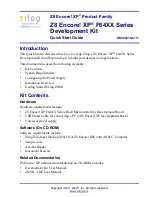UM10462
All information provided in this document is subject to legal disclaimers.
© NXP B.V. 2016. All rights reserved.
User manual
Rev. 5.5 — 21 December 2016
459 of 523
NXP Semiconductors
UM10462
Chapter 24: LPC11U3x/2x/1x Appendix ARM Cortex-M0
•
If
n
is 32, then the value of the result is same as the value in
Rm
, and if the carry flag
is updated, it is updated to bit[31] of
Rm
.
•
ROR
with shift length,
n
, greater than 32 is the same as
ROR
with shift length
n
-32.
24.4.3.4 Address alignment
An aligned access is an operation where a word-aligned address is used for a word, or
multiple word access, or where a halfword-aligned address is used for a halfword access.
Byte accesses are always aligned.
There is no support for unaligned accesses on the Cortex-M0 processor. Any attempt to
perform an unaligned memory access operation results in a HardFault exception.
24.4.3.5 PC-relative expressions
A PC-relative expression or
label
is a symbol that represents the address of an instruction
or literal data. It is represented in the instruction as the PC value plus or minus a numeric
offset. The assembler calculates the required offset from the label and the address of the
current instruction. If the offset is too big, the assembler produces an error.
Remark:
•
For most instructions, the value of the PC is the address of the current instruction plus
4 bytes.
•
Your assembler might permit other syntaxes for PC-relative expressions, such as a
label plus or minus a number, or an expression of the form [PC, #
imm
].
24.4.3.6 Conditional execution
Most data processing instructions update the condition flags in the
Application Program
Status Register
(APSR) according to the result of the operation, see
instructions update all flags, and some only update a subset. If a flag is not updated, the
original value is preserved. See the instruction descriptions for the flags they affect.
You can execute a conditional branch instruction, based on the condition flags set in
another instruction, either:
•
immediately after the instruction that updated the flags
•
after any number of intervening instructions that have not updated the flags.
Fig 85. ROR #3
&DUU\
)ODJ


















